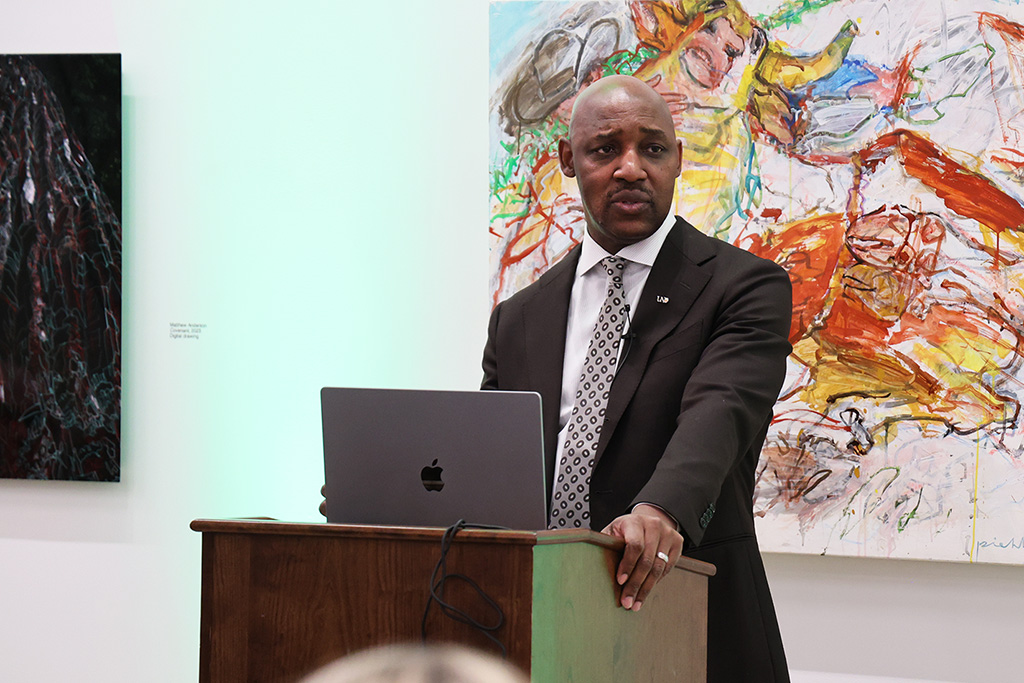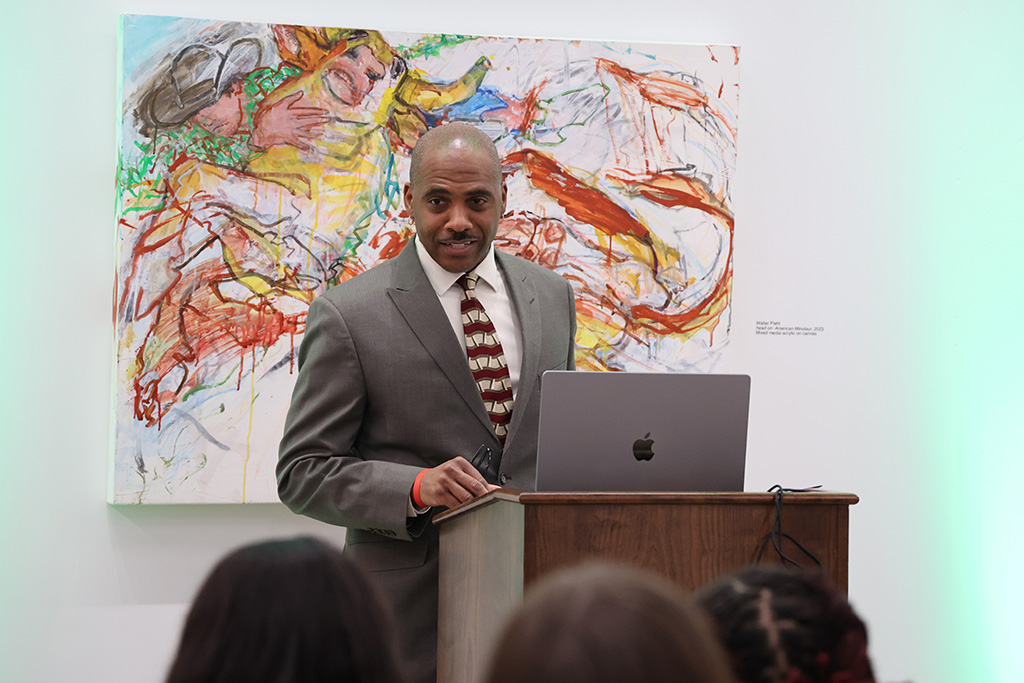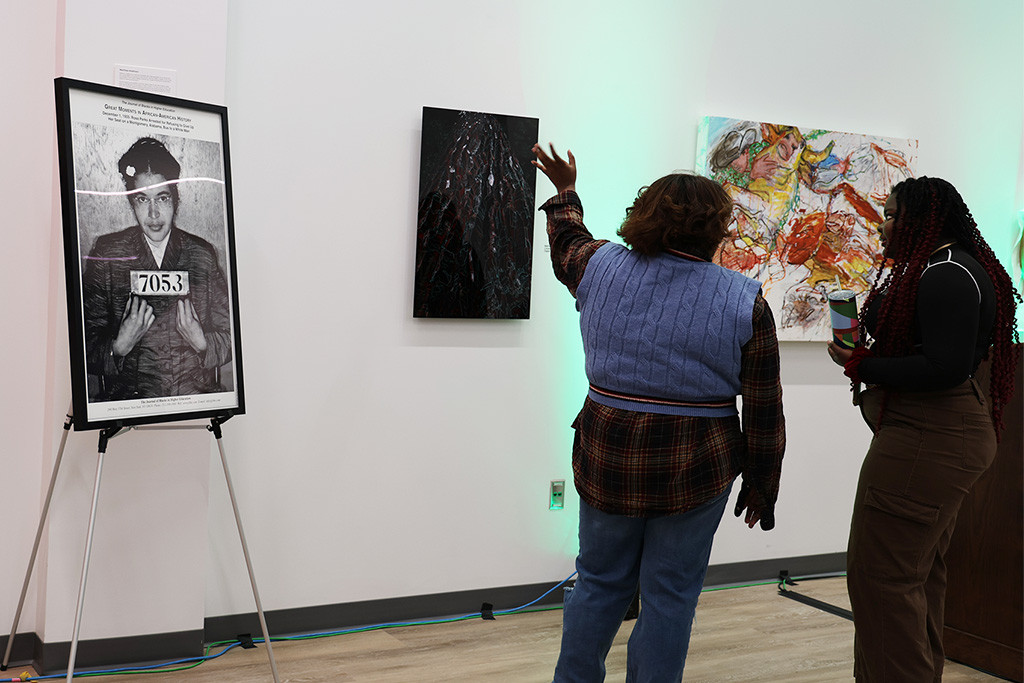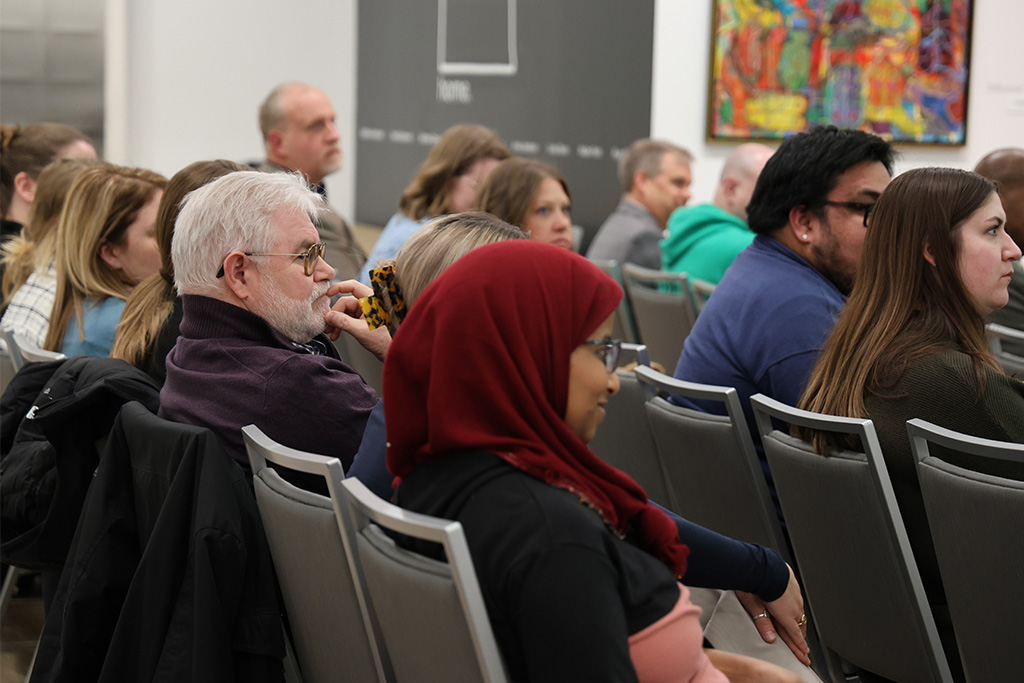Rosa Parks sat down, America stood up
For Black History Month, Art Malloy delivers lecture on the woman who inspired justice, unity in a fractured nation

Rosa Parks was tired on Dec. 1, 1955. On that day, James F. Blake, a bus driver for the Montgomery City Lines, demanded she move for white patrons. Just six months prior, a teenager named Emmett Till was lynched by a mob in Mississippi, and the event was weighing on her mind.
She told Blake no.
She wasn’t physically tired, though. “She was tired of giving in,” said Tamba-Kuii Bailey, special assistant to the president for diversity and inclusion at UND, as he welcomed the audience at the University’s inaugural Rosa Parks lecture on Feb. 13 in the Memorial Union Gallery.
As part of this year’s Black History Month programming, the lecture would be the first in “a new tradition” of Rosa Parks lectures, said Stacey Barboa-Peterson, director of Student Diversity & Inclusion.
Parks was neither the first nor last person to protest the South’s Jim Crow segregation, Bailey noted, as a woman named Mary Smith-Ware and a teenager named Claudette Colvin had refused to give up their seats earlier that same year. She was, however, a catalyst for a national movement for civil rights and a symbol of civil disobedience against unjust laws.
“I think it was this undying spirit for fighting for her rights, fighting for her dignity, as well as the dignity of other Black people, particularly in Montgomery, Ala., that makes her an icon of the civil and human rights movements,” he said.
Following his speech, Bailey invited graduate student Precious Dada to the podium to introduce the featured speaker Art Malloy.

Rosa Parks and the ‘Politics of Protest’
Malloy, UND’s vice president of Student Affairs, presented his lecture titled “Politics of Protest,” which offered a panoramic view of the historical impact of Parks and the coalition-building strategy that made the movement’s victories possible.
“The politics of protesting is simply using protest as a means to bring about change,” said Malloy, who noted that the protests that advanced the Civil Rights movement represented a diverse community, and employed diverse tactics to form a “united front” in pursuit of justice.
That united front was necessary to transform America. Despite the passage of the Fifteenth Amendment in 1869, which protected the right to vote for all people, Black people and other minorities were still turned away at the polls and faced disenfranchisement well into the 20th century.
This discrimination was especially confounding given the service Black people had given to the country in its most significant times of need. Malloy offered a brief history of Black Americans who served the United States, which included accounts of Crispus Attucks, a Black and Native American man and the first person to have died in the American Revolution, and the 1.5 million Black Americans who served in World War II.
“Blacks had gone to defend this country, Blacks gave their lives for this country,” he said. “Then they came home to this situation where they could not ride on buses where they wanted to ride; they were relegated to the back of the buses.”
But the tide was turning by the 1950s, said Malloy, as events in previous decades, including the women’s suffrage movement and the Harlem Renaissance, signaled a move toward progress in the country. By the time the Supreme Court ruled in the case of Brown v. Board of Education, the movement had gained an unstoppable momentum.
“I believe that 1954 gave everybody – and I mean everybody – the green light to say, ‘Hey, the situation for Blacks in the United States has to get better.'”
It was after Emmett Till’s death by lynching and Rosa Parks’ defiance of segregation that Martin Luther King Jr. rose as a figurehead of the Civil Rights movement. Those developments, in turn, helped lead to watershed moments such as the Civil Rights Act of 1964 and the Voting Rights Act of 1965.

A movement marked by diversity, solidarity
But King didn’t do it alone; the united front’s approaches to protest were manifold. Malloy gave an overview of the tactics ranging from sit-ins organized by the Student Nonviolent Coordinating Committee – founded in 1960 at Malloy’s alma mater, Shaw University – and the Freedom Rides organized by the Congress of Racial Equality, as well as the more militant and confrontational methods used by the Black Panther Party.
“Now, I want you to look at these pictures very carefully,” Malloy said, gesturing to a monitor displaying photos of protests. He pointed out one of the photos, taken at a sit-in that SNCC staged at a Woolworth’s department store in North Carolina after four Black students were denied service. He noted that, in that photo, the protesters were diverse.
“The Civil Rights Movement was a movement that incorporated everyone. It incorporated women, it incorporated whites, it incorporated the LBGT community, it incorporated Native Americans, it incorporated people from all over the world. It was it was a movement that was signified by unity,” he noted.
Though Malloy acknowledged the risks of standing against discrimination, citing the deaths of many leaders (including Malcolm X and Martin Luther King Jr.), he said the protests were successful in shaping the nation.
The Civil Rights Act of 1964, the Voting Rights Act of 1965, the Fair Housing Act of 1968, and the Equal Employment Act of 1972 were all examples of the success of the “rainbow coalition” of the united front.
“It was because of a coalition of people that were parts of all of these organizations who decided that they were going to take their cues from Rosa Parks,” Malloy said. “Rosa Parks sat down and, as a result of her sitting down to protest injustice and inequality, a whole nation decided to stand up.
“They stood up in a united front, and they accomplished all of the wonderful things that allow me and Dr. Bailey to stand in front of you today,” he said.
As Malloy closed his lecture, he reminded the audience of how the legacy of Rosa Parks – a woman whose actions inspired unification in a fractured country – is cause for celebration to this day.
“There’s a reason for all of us to celebrate Black History Month. Everyone should celebrate Black history, because we all had a hand in things getting to the point where they are,” he said. “When we stand united, we can do wonderful things.”

More events to come for UND’s Black History Month
The Office of Student Diversity & Inclusion will continue to hold Black History Month events for the rest of February, including the Black Student Experience Panel in Memorial Union 201 at 1 p.m. on Feb. 22 and a concert by folk singer Hubby Jenkins at the North Dakota Museum of Art at 2 p.m. on Feb. 24.



